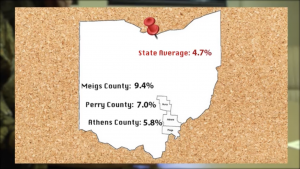
Finding Jobs in Southeast Ohio is a Challenge for Many Locals
By: Joseph Payton, Lauren Ramoser, Megan Ryan
Posted on:
It is the most basic of needs. To be able to provide a home, meals and clothing for ourselves and our families. That usually means a job that pays a living wage. However, for residents of counties in Southeast Ohio, finding that job can be a difficult challenge. That challenge exists for a number of reasons, but there are a few key factors that play a role in the underemployment in this region.
https://www.youtube.com/watch?v=4PCW__Qxt64
Unemployment
Unemployment is calculated as the percentage of people who are currently without a job and looking for work. Jean Demosky is the director at the Workforce Development Board. She deals with local business to find out what jobs are open and to help fill those positions.
“Well we have unemployment rates all across the state. In our area, Athens, Meigs, and Perry, Meigs has one of the highest unemployment rates in the state. Athens is kind of in the middle and Perry is on the upper side,“ said Demosky.

Let’s first look at the unemployment numbers in Southeast Ohio. According to U.S. Census data, Meigs County has the second highest unemployment rate of all 88 Ohio counties at 9.4%. Perry County’s unemployment rate is at 7% and Athens County’s jobless rate is 5.8%.
When you compare that to the Buckeye state’s average unemployment rate of 4.7%, it is evident that there is a problem here in this region. And it’s not just about those who do not have a job, there is also a problem of underemployment–those who only can find part time work or are working in low paying jobs that do not utilize their skills or education.
Poverty
Probably the most telling factor that plays into the underemployment issue in southeast Ohio is the poverty rate. Many jobs require people to have a four-year degree or some sort of training at a trade school. However, if a person does not have the resources to get that training or education, it can effect their marketability to possible employers.
Poverty rates in Southeast Ohio, like unemployment rates, are among the highest in the state. In Athens County, 28% of residents live below the poverty rate. In Meigs County, 21.1% of residents live below the poverty line and the poverty rate is 20.6% in Perry County. In the entire state of Ohio, 14.6% of residents live below the poverty line.
https://www.youtube.com/watch?v=c1kmHnK75pM
Resources
Because of these staggering numbers in the region, there are some valuable resources for locals looking for jobs and job training. One of those resources is the Ohio Means Jobs Center. Laurie Gribble-McKnight is the Workforce Innovation and Opportunities coordinator at the Ohio Means Job Center. She helps people get qualified for the local jobs that are available.
“We don’t have a lot of manufacturing jobs. The small business development center is working very hard to get more manufacturing jobs in our area. The wages that are offered in Athens County are more low-income wages. Even if you’re working 40 hours a week at minimum wage, you’re still going to be eligible for food stamps possibly and a medical card. So the problem is getting people better jobs with better pay,“ says Gribble-Mcknight.

Stacia Mills is someone who found the Ohio Means Jobs Center very useful in her job hunt. Through the Ohio Means Job Center, she finished school and found a job with Interim Health Care as a home health nurse in order to provide for her eight-year-old son.
“Had they not had the program and funding, I don’t think I’d be sitting here. I ran out of financial aid, and they helped me pay for my last semester and I’m very grateful,“ said Mills.
Along with helping to pay for Mill’s final semester of school, the Center also helped her pay for books and provided the technology that she needed to do her schoolwork.
The Center also helps people find employers who will do on-the-job training. Bruce Underwood, the Executive Director at Athens-Hocking Recycling, believes that his company provides some great occupational opportunities for those looking for work.

“I think we’ve made some good opportunities here for somebody who has been able to come in, essentially here at the facility here some of the jobs are unskilled labor. It gives people the opportunity to start here at least as a stepping stone towards something else,” said Underwood.
Underwood currently employs 37 people at the Athens-Hocking Recycling Center. Not only does the recycling center provide jobs, but Underwood and his staff provide employees with the training and skills that they need to work the heavy equipment at the recycling center. For example they help employees get their commercial drivers license to operate and drive his company’s machinery. That C.D.L. could also be used to drive other large commercial vehicles such as large cargo trucks.
The efforts by people like Bruce Underwood at the Athens-Hocking Recycling Center, Laurie Gribble-McKnight at the Ohio Means Jobs Center and Jean Demosky at the Workforce Development Board, have definitely paid dividends. Athens County’s unemployment rate dropped from nearly 10 percent in 2011 to just under 6 percent in 2018. But that still leaves a lot of people like Stacia Mills who needed a little help in the right areas to succeed and now provide for her son in the way she always wanted to.
https://animoto.com/play/jyFK2egAs0WYZgt1KKlNmg

